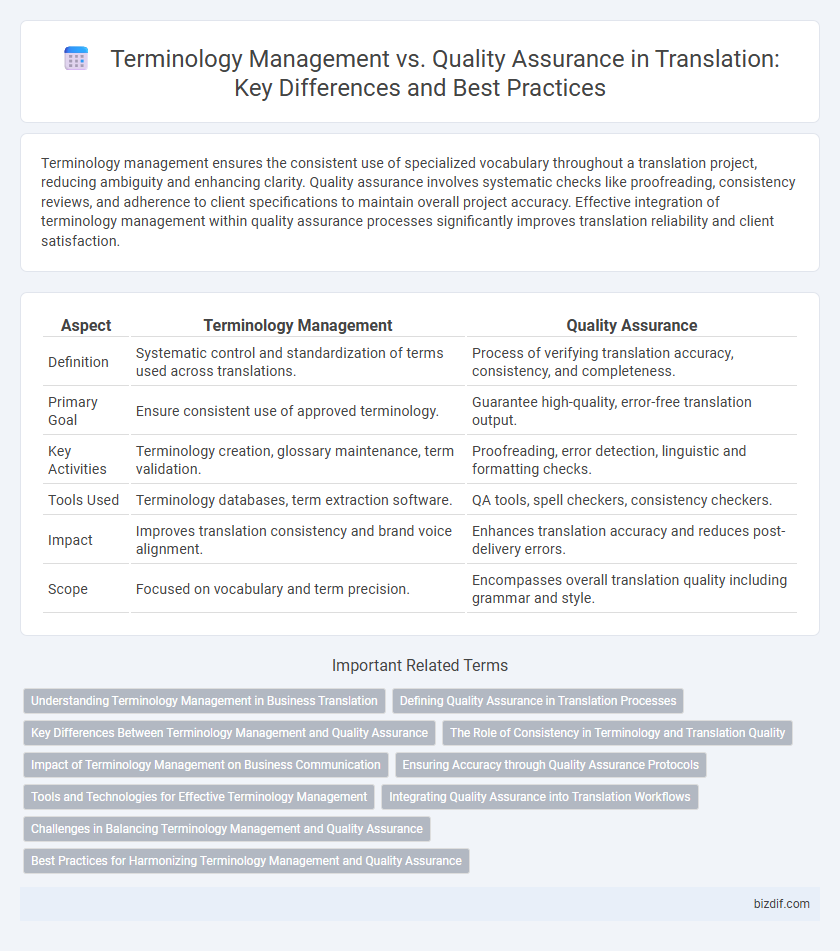Terminology management ensures the consistent use of specialized vocabulary throughout a translation project, reducing ambiguity and enhancing clarity. Quality assurance involves systematic checks like proofreading, consistency reviews, and adherence to client specifications to maintain overall project accuracy. Effective integration of terminology management within quality assurance processes significantly improves translation reliability and client satisfaction.
Table of Comparison
| Aspect | Terminology Management | Quality Assurance |
|---|---|---|
| Definition | Systematic control and standardization of terms used across translations. | Process of verifying translation accuracy, consistency, and completeness. |
| Primary Goal | Ensure consistent use of approved terminology. | Guarantee high-quality, error-free translation output. |
| Key Activities | Terminology creation, glossary maintenance, term validation. | Proofreading, error detection, linguistic and formatting checks. |
| Tools Used | Terminology databases, term extraction software. | QA tools, spell checkers, consistency checkers. |
| Impact | Improves translation consistency and brand voice alignment. | Enhances translation accuracy and reduces post-delivery errors. |
| Scope | Focused on vocabulary and term precision. | Encompasses overall translation quality including grammar and style. |
Understanding Terminology Management in Business Translation
Terminology Management in business translation ensures consistent use of specialized vocabulary across all documents, enhancing clarity and brand integrity. It involves creating and maintaining comprehensive termbases that align with industry standards and company-specific language. Effective terminology control reduces errors and accelerates the translation process, directly impacting overall quality assurance.
Defining Quality Assurance in Translation Processes
Quality Assurance in translation processes ensures consistency, accuracy, and cultural appropriateness by systematically reviewing and validating terminology, style, and context. It involves implementing standardized procedures such as glossary maintenance, translation memory updates, and regular quality checks to minimize errors and improve communication effectiveness. Effective QA integrates linguistic expertise with technology, enhancing overall translation reliability and client satisfaction.
Key Differences Between Terminology Management and Quality Assurance
Terminology Management focuses on creating, standardizing, and maintaining consistent use of specific terms across translation projects to ensure accuracy and brand consistency. Quality Assurance encompasses a broader scope, including error detection, linguistic quality checks, and adherence to client specifications throughout the entire translation workflow. Key differences lie in Terminology Management's emphasis on correct term usage versus Quality Assurance's comprehensive validation of overall translation quality and compliance.
The Role of Consistency in Terminology and Translation Quality
Terminology management ensures consistency by standardizing terms across all translated materials, which significantly enhances translation quality by reducing ambiguity and maintaining brand voice. Consistent terminology helps translators produce accurate and reliable content, minimizing errors and improving readability for target audiences. Effective quality assurance processes leverage terminology databases to verify that the correct terms are used, reinforcing overall translation integrity and coherence.
Impact of Terminology Management on Business Communication
Effective terminology management enhances business communication by ensuring consistent and precise use of terms across all translated materials, which reduces misunderstandings and strengthens brand identity. It streamlines collaboration among translators and stakeholders, minimizing errors and improving overall translation quality. Consistent terminology directly influences client trust and supports regulatory compliance, crucial for global business operations.
Ensuring Accuracy through Quality Assurance Protocols
Terminology management ensures consistent use of domain-specific terms across translations, reducing ambiguity and enhancing clarity. Quality assurance protocols systematically verify translation accuracy by cross-referencing terminology databases, checking for linguistic errors, and maintaining style consistency. Implementing rigorous quality checks guarantees that translations not only align with client requirements but also uphold industry standards for precision and reliability.
Tools and Technologies for Effective Terminology Management
Effective terminology management relies on specialized tools such as term base management systems (TBMS) and translation memory (TM) software that ensure consistency across multilingual projects. Integration with quality assurance (QA) technologies enables automated verification of term adherence, reducing errors and improving translation accuracy. Advanced platforms incorporate machine learning algorithms to continuously update and refine terminology databases, enhancing both productivity and linguistic precision.
Integrating Quality Assurance into Translation Workflows
Integrating Quality Assurance into translation workflows enhances consistency and accuracy by systematically incorporating terminology management tools that enforce standardized language use across projects. This approach minimizes errors, improves client satisfaction, and streamlines the review process through automated checks and glossary adherence. Efficient terminology management combined with quality assurance protocols ensures translations meet linguistic and domain-specific standards, optimizing overall output quality.
Challenges in Balancing Terminology Management and Quality Assurance
Balancing terminology management and quality assurance in translation presents challenges such as maintaining consistency across multilingual content while adapting to varying QA standards and client expectations. Terminology databases require regular updates to reflect changes, yet excessive rigidity can hinder linguistic creativity and naturalness. Ensuring seamless integration between terminology tools and QA processes remains critical to deliver accurate, culturally relevant translations without compromising efficiency.
Best Practices for Harmonizing Terminology Management and Quality Assurance
Effective terminology management ensures consistent use of domain-specific terms, directly enhancing translation quality by reducing ambiguity and errors. Implementing standardized glossaries integrated with quality assurance tools facilitates automatic term verification, streamlining the review process and maintaining linguistic accuracy. Regular collaboration between terminologists and translators promotes continuous updates, aligning terminology with evolving industry standards and improving overall translation reliability.
Terminology Management vs Quality Assurance Infographic

 bizdif.com
bizdif.com